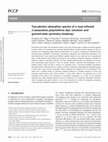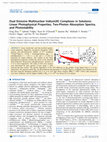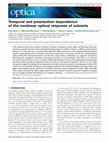Papers by Eric Van Stryland

Physical Chemistry Chemical Physics, 2013
Polymethine dyes (PDs) with absorption bands in the near-infrared region undergo symmetry breakin... more Polymethine dyes (PDs) with absorption bands in the near-infrared region undergo symmetry breaking in polar solvents. To investigate how symmetry breaking affects nonlinear optical responses of PDs, an extensive and challenging experimental characterization of a cationic 2-azaazulene polymethine dye, including linear absorption, fluorescence, two-photon absorption and excited-state absorption, has been performed in two solvents with different polarity. Based on this extensive set of experimental data, a three-electronic-state model, accounting for the coupling of electronic degrees of freedom to molecular vibrations and polar solvation, has been reliably parameterized and validated for this dye, fully rationalizing optical spectra in terms of spectral position, intensities and bandshapes. In lowpolarity solvents where the dye is mainly in its symmetric form, a nominally forbidden two-photon absorption band is observed, due to a vibronic activation mechanism. Inhomogeneous broadening plays a major role in polar solvents: absorption spectra represent the weighted sum of contributions from states with a variable amount of symmetry breaking, leading to a complex evolution of linear and nonlinear optical spectra with solvent polarity. In more polar solvents, the dominant role of the asymmetric form leads to the activation of two-photon absorption as a result of the symmetry lowering. The subtle interplay between the two mechanisms for two-photon absorption activation, vibronic coupling and polar solvation, can be fully accounted for within the proposed microscopic model allowing a detailed interpretation of the optical spectra of PDs.
Conference on Lasers and Electro-Optics
Using Beam-Deflection measurements we directly measure the temporal dynamics of nonlinear refract... more Using Beam-Deflection measurements we directly measure the temporal dynamics of nonlinear refraction and transmittance of an ITO thin film in the -near-zero regime, and find a nonlinear index 5000 times that of glass.
Frontiers in Optics 2017
High-spectral-irradiance infrared supercontinuum with fundamental Gaussian spatial profile was ge... more High-spectral-irradiance infrared supercontinuum with fundamental Gaussian spatial profile was generated in Krypton gases. We demonstrate its usefulness for Z-scan nonlinear spectroscopy in the 800-1600nm spectral range using GaAs and CS 2 .
Conference on Lasers and Electro-Optics
An investigation of Ir(III) complexes has been performed using double-pump probe (DPP) experiment... more An investigation of Ir(III) complexes has been performed using double-pump probe (DPP) experiments to decouple the triplet quantum yield and triplet cross-section of these complexes. Both femtosecond and picosecond DPP measurements are presented.
Conference on Lasers and Electro-Optics
Transient nondegenerate nonlinear refraction of Indium Tin Oxide has been characterized in the ne... more Transient nondegenerate nonlinear refraction of Indium Tin Oxide has been characterized in the near-infrared using femtosecond Beam-Deflection with independently tuned excitation and probe. ENZ enhancement depends more strongly on the probe wavelength than the excitation.
LEOS '90. Conference Proceedings IEEE Lasers and Electro-Optics Society 1990 Annual Meeting
ABSTRACT
Technical Digest. Summaries of papers presented at the Conference on Lasers and Electro-Optics. Postconference Edition. CLEO '99. Conference on Lasers and Electro-Optics (IEEE Cat. No.99CH37013)
Summary form only given. A variety of experimental techniques for measuring nonlinear refractive ... more Summary form only given. A variety of experimental techniques for measuring nonlinear refractive and absorptive coefficients has been invented and developed during the last two decades. Here we concentrate on perhaps the simplest of these methods-the so-called Z-scan technique. By varying the position of a sample with respect to the focal plane of an input lens and detecting the energy
2005 Quantum Electronics and Laser Science Conference
Nonlinear Optics
Weakly focused, near mJ, 1800nm femtosecond pulses in a 1.8m Krypton gas chamber generates a high... more Weakly focused, near mJ, 1800nm femtosecond pulses in a 1.8m Krypton gas chamber generates a high-spectral-irradiance, Gaussian spatial profile continuum for nonlinear spectroscopy in the 800-1600nm range. We demonstrate its usefulness with Z-scans on GaAs.
Nonlinear Optics
We measure nondegenerate nonlinear refraction of ITO as we tune the excitation wavelength through... more We measure nondegenerate nonlinear refraction of ITO as we tune the excitation wavelength through Epsilon-Near-Zero (ENZ) for a fixed probing wavelength. Unlike the degenerate case, there is no observed peak in the nonlinearity at ENZ.
Nonlinear Optics '98. Materials, Fundamentals and Applications Topical Meeting (Cat. No.98CH36244)
ABSTRACT
17th Congress of the International Commission for Optics: Optics for Science and New Technology
Organic material 3-Methyl-4-methoxy-4'-nitrostilbene(MMONS) exhibits one of the largest powde... more Organic material 3-Methyl-4-methoxy-4'-nitrostilbene(MMONS) exhibits one of the largest powder second harmonic signals and has a great potential in frequency doubling and parametric conversion. The large second order nonlinear optical effect in this material attracts great interests because the phase shifts due to the second-order cascading effect can be utilized for the practical switching device.
Nature Photonics
In the version of Article originally published, a graphical handling error occurred, leading to t... more In the version of Article originally published, a graphical handling error occurred, leading to the y-axis values and tick placement from Fig. 2a being duplicated in Fig. 2b. The correct panel b y-axis, ranging from 10 0-10 3 (rather than 10-1-10 3) is shown below.
Conference on Lasers and Electro-Optics
We report beam-deflection measurements of indium tin oxide excited around epsilon-near-zero (ENZ)... more We report beam-deflection measurements of indium tin oxide excited around epsilon-near-zero (ENZ), but probed far from ENZ. Nonlinear refraction is very large even far from ENZ and enhanced as the excitation is tuned through ENZ. © 2019 The Author(s)
Conference on Lasers and Electro-Optics
Using Beam-Deflection measurements we directly measure the temporal dynamics of nonlinear refract... more Using Beam-Deflection measurements we directly measure the temporal dynamics of nonlinear refraction and transmittance of an ITO thin film in the -near-zero regime, and find a nonlinear index 5000 times that of glass.

The Journal of Physical Chemistry C
Linear steady-state and time-resolved spectroscopic properties, degenerate two-photon absorption ... more Linear steady-state and time-resolved spectroscopic properties, degenerate two-photon absorption (2PA) spectra, and photochemical stability of Ir III complexes TCQ[Ir III (ppz) 2 ] n , (TCQ = tricycloquinazoline; ppz = 1phenylpyrazole; n = 1 (1), n = 2 (2), and n = 3 (3)) are presented for liquid solutions. The analysis of the linear photophysical properties revealed the nature of the observed dual-component fluorescence−phosphorescence emission of 1−3 at room temperature. The values of 2PA cross sections were determined by open aperture Z-scans using a 1 kHz femtosecond laser system. The specific dependence of the 2PA efficiency on the number of ppz ligand units in 1−3 was determined. The quantum yields, Φ ph , for photochemical decomposition of TCQ[Ir III (ppz) 2 ] n complexes were obtained for the first time using the absorption method [Cui, L.-S.; et al. ACS Appl. Mater. Interfaces 2015, 7, 11007−11014] with continuous wave laser irradiation, and the highest stability of Φ ph ≈ 4 × 10 −6 was shown for 2 in toluene. 50 for these complexes by femtosecond transient absorption 51 spectroscopy. 22,23 Time-resolved dual emission processes in Ir 52 complexes in solutions were previously reported in refs 19, 37 53 and characteristic luminescence peculiarities were explained by 54 the double minima excited-state potential energy surface. The 55 investigations of the molecular photochemical stability of 56 metal−organic compounds are rarely presented, and those 57 that are presented mainly concern relative measurements of the 58 temporal changes in the absorption or luminescence spectra, 59 i.e., the rates of photodecomposition occurring under photo-60 excitation as compared with reference objects. 38−41 The results 61 of these types of measurements are strictly dependent on the 62 employed experimental conditions and, in general, cannot serve 63 as molecular characteristics of photostability, such as the 64 photochemical decomposition quantum yield, Φ ph. It should be 65 mentioned that the determination of values of Φ ph allow correct 66 comparisons of the photostability for different molecular 67 structures. 42 68 Here, we continue linear spectroscopic and nonlinear optical 69 investigations of these new Ir III complexes with tricycloquinazo-70 line TCQ[Ir III (ppz) 2 ] n (TCQ = tricycloquinazoline; ppz = 1-71 phenylpyrazole; n = 1 (1), n = 2 (2), and n = 3 (3)) in liquid 72 solutions at room temperature, including the steady-state and
Frontiers in Optics 2017
High-spectral-irradiance infrared supercontinuum with fundamental Gaussian spatial profile was ge... more High-spectral-irradiance infrared supercontinuum with fundamental Gaussian spatial profile was generated in Krypton gases. We demonstrate its usefulness for Z-scan nonlinear spectroscopy in the 800-1600nm spectral range using GaAs and CS 2 .
Conference on Lasers and Electro-Optics
An investigation of Ir(III) complexes has been performed using double-pump probe (DPP) experiment... more An investigation of Ir(III) complexes has been performed using double-pump probe (DPP) experiments to decouple the triplet quantum yield and triplet cross-section of these complexes. Both femtosecond and picosecond DPP measurements are presented.

Optica
It has long been known that nonlinear refraction in solvents can depend on pulse width, and this ... more It has long been known that nonlinear refraction in solvents can depend on pulse width, and this along with experimental uncertainties has led to orders-of-magnitude disagreements in nonlinear refractive coefficients reported in the literature. To resolve this issue, we perform beam-deflection (BD) measurements of the rigorously defined nonlinear impulse response function for 24 commonly used solvents selected from various classes of molecules. Using this polarization-resolved BD, the bound-electronic and the three major nuclear contributions are separately measured by determining the magnitudes, symmetry, and temporal dynamics of each mechanism. This allows us to construct the response functions that we use to accurately establish self-consistent references for predicting and interpreting the outcomes of other experiments performed on these materials over the temporal range from 10 fs to 1 ns. The results also provide insight into relating solvent nonlinearities with their molecular structures and exploring the effects of the Lorentz-Lorenz local field. We find that nonconjugated molecules with small polarizability anisotropy exhibit negligible reorientational response, and hence the nonlinear refraction is almost independent of pulse width. Knowledge of the response functions also allows engineering the transient nonlinear refractive properties of solutions of organic dyes, for example, materials with effectively zero nonlinear refraction.
Conference on Lasers and Electro-Optics
Transient nondegenerate nonlinear refraction of Indium Tin Oxide has been characterized in the ne... more Transient nondegenerate nonlinear refraction of Indium Tin Oxide has been characterized in the near-infrared using femtosecond Beam-Deflection with independently tuned excitation and probe. ENZ enhancement depends more strongly on the probe wavelength than the excitation.

Uploads
Papers by Eric Van Stryland